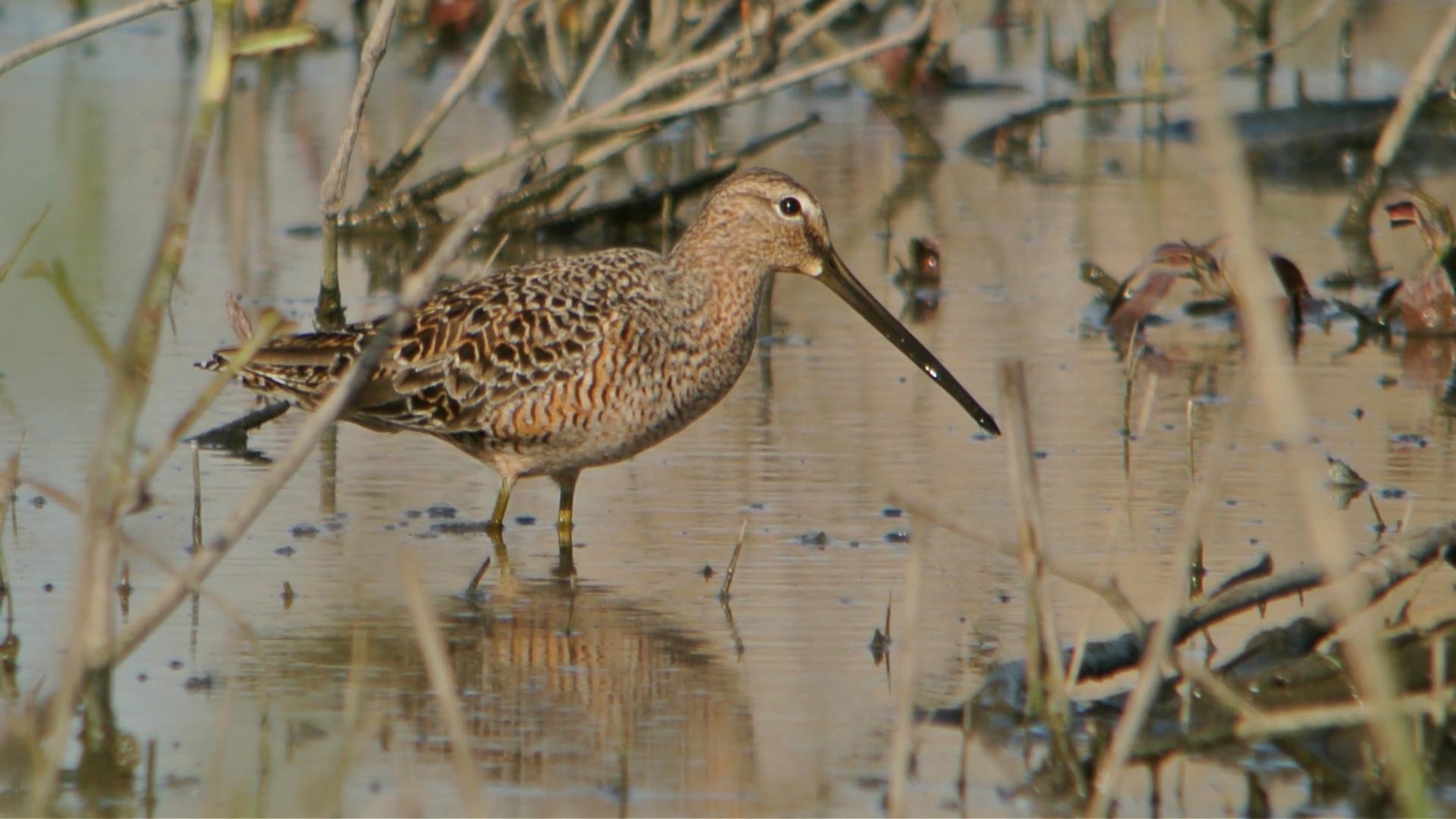Long-billed Dowitcher
A species of Dowitchers Scientific name : Limnodromus scolopaceus Genus : Dowitchers
Long-billed Dowitcher, A species of Dowitchers
Botanical name: Limnodromus scolopaceus
Genus: Dowitchers
 Photo By Andy Reago & Chrissy McClarren , used under CC-BY-2.0 /Cropped and compressed from original
Photo By Andy Reago & Chrissy McClarren , used under CC-BY-2.0 /Cropped and compressed from original Description
The Long-billed dowitcher is a medium-sized, stocky sandpiper with a bill about twice the length of its head. In all plumages, the long-billed dowitcher has a whitish supercilium and dark loral stripe that continuous past the eye. The tail is barred black and white with the black being almost twice the width of the white and a large distinctive white rump which extends up to the middle of its back. Long-billed dowitcher are in breeding plumage from approximately May to late August or early September. In breeding plumage, adults are characterized by a dark crown on top of their head and a rufous neck, chest, and belly underneath with black bars on their breast and white barring on flanks when plumage is fresh. The older the feathers get the less the black bars may appear leaving the breast dark redish. The crown and the back are a mix of brown, black and buff markings. Wings and upper-back are mottled with black, buff, and white markings looking overall dark brown. When in the winter plumage the long-billed dowitcher is very difficult to identify in the field with the short-billed dowitcher.In non-breeding plumage, adults are drab grey, with darker upperparts and breast contrasting with paler white belly. The gray of the breast also gradually lightens as it reaches the chin. The juvenile plumage of the long-billed dowitcher is similar to that of the breeding adult except for being paler. Juvenile long-billed dowitcher can be distinguished from the short-billed dowitcher by the differences in the tertiary feathers. On the long-billed dowitcher these feathers are dark gray with narrow buff edges with internal markings so dull they seem to lack them altogether. In juvenile birds the upper parts are fringed chestnut rather than buffy brown and their uniformly gray breast is slightly demarcated from the pale rufous lower belly and breasts. The bill of the long-billed dowitcher ranges from 62 mm to 72 mm with males having bill lengths near the smaller scale reflecting their smaller body size. Bills are typically very straight and black becoming yellowish olive-green near the base and legs are also yellowish. Sexes are almost identical, with females being generally heavier and having longer wings and bill. Measurements: Length: 11.4 in (29 cm) Weight: 3.1-4.6 oz (88-131 g) Wingspan: 18.5-19.3 in (47-49 cm) 
Size
28-32 cm (11-12.5 in)
Colors
Brown
Black
Yellow
Bronze
Gray
White
Life Expectancy
8.3 years
Nest Placement
Ground
Clutch Size
3 - 4 eggs
Incubation Period
1 brood
Number of Broods
21 - 22 days
Feeding Habits
Long-billed Dowitcher's diet consists mainly of insects, aquatic invertebrates, and some plant matter. They probe into wet substrates for food, sometimes submerging their heads, and are adapted to feed at night. Their diet includes midges, worms, beetles, caterpillars, small crustaceans, and bivalves like amethyst and Baltic macoma clams.
Habitat
Long-billed Dowitcher thrives in wetland habitats such as mudflats, shallow pools, and marshy areas, predominantly in freshwater environments. These birds are adapted to low-altitude wet lowlands, including sedge meadows and foothills with scattered ponds necessary for foraging. Post-breeding, they migrate to coastal regions, especially estuaries and lakes. During migration and winter, long-billed Dowitcher occupies diverse wet habitats, preferring areas with a muddy substrate and shallow waters.
Nest Behavior
The specifics of long-billed Dowitcher's nest site selection and construction by the sexes remain unknown. They engage in timed nest building and egg-laying, with both parents potentially involved in nurturing the young.
Nest Characteristics
Long-billed Dowitcher nests are deep cups located in marsh vegetation near small ponds, typically on raised tussocks or hummocks. They are lined with grasses, sedges, and leaves, measuring approximately 4.5 inches across and 2.2 inches deep.
Dite type
Aquatic invertebrate eater
People often ask
Migration Overview
The long-billed dowitcher will migrate later in the fall than the short-billed dowitcher and earlier in the spring. The spring migrations occurs from February to May with birds moving up along the Pacific coast and interior. The long-billed dowitcher will also migrate through the Great Plains on the western side with a vast majority moving through Alberta. The fall migrations generally occurs from July to October with the adult long-billed dowitcher beginning to migrate south in July while juveniles begin migrating through September to October. From their breeding grounds the long-billed dowitcher will either migrate south along the Pacific Coast, across the Canadian Prairies and down the Great Basin or through Ontario towards Florida. 
General Info
Feeding Habits
Bird food type
Sounds
Call
Recording location: United States
Call
Recording location: United States
Behavior
Long-billed Dowitcher's behavior can be described as somewhat elusive due to its remote breeding grounds. These birds are likely monogamous and display less aggression than other shorebirds in similar habitats. Daily activities involve a mix of territorial displays and communal feeding, with unique aerial song flights reaching 60 feet high, executed by males to attract females. Interestingly, they exhibit a cooperative spirit while feeding in small ponds, tolerating nesting neighbors without territorial disputes, indicating a complex spectrum of behavior ranging from territorial to social within the same species.
Species Status
Not globally threatened.

 Photo By Andy Reago & Chrissy McClarren , used under CC-BY-2.0 /Cropped and compressed from original
Photo By Andy Reago & Chrissy McClarren , used under CC-BY-2.0 /Cropped and compressed from original Scientific Classification
Phylum
Chordates Class
Birds Order
Shorebirds Family
Sandpipers Genus
Dowitchers Species
Long-billed Dowitcher